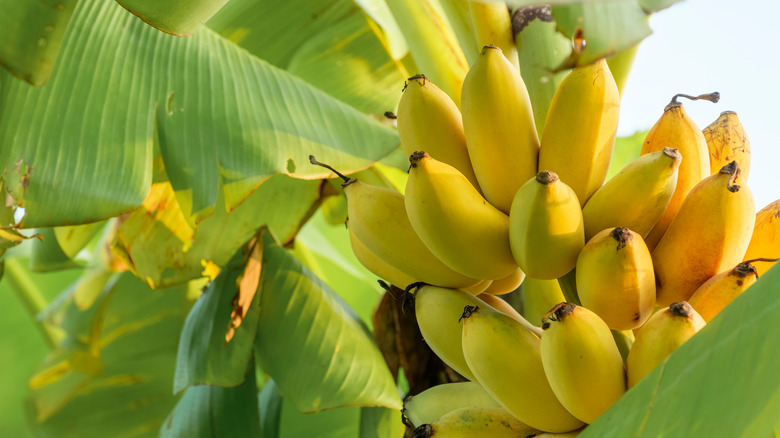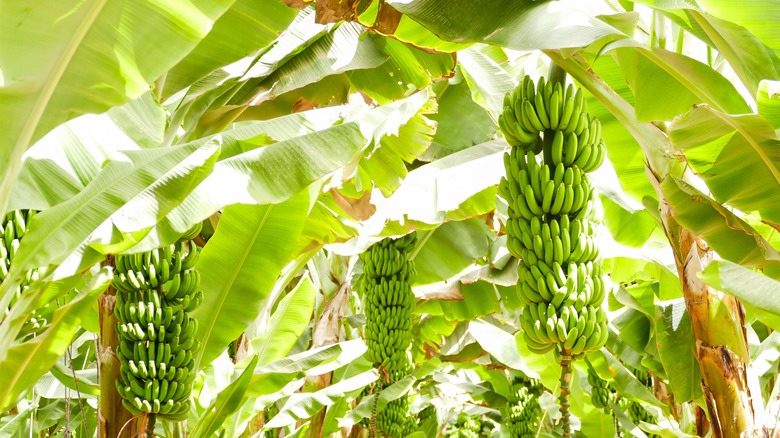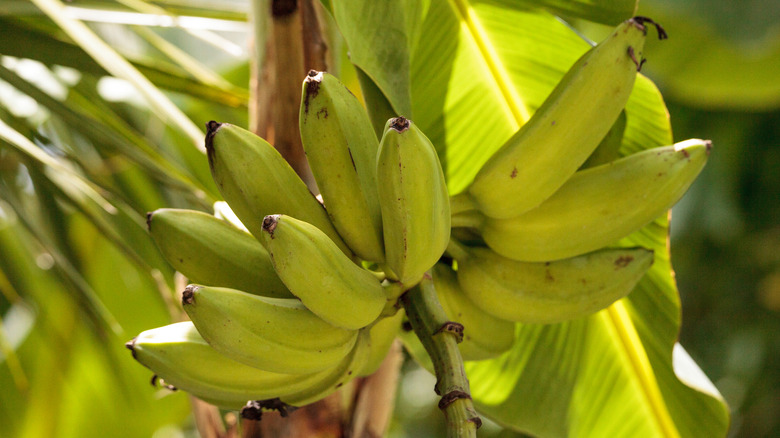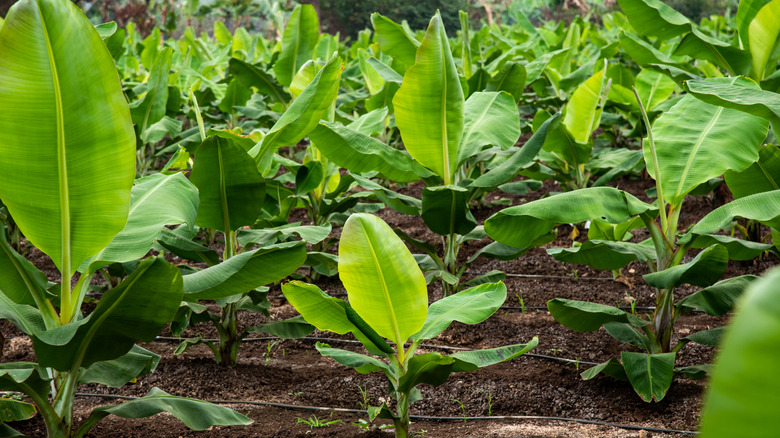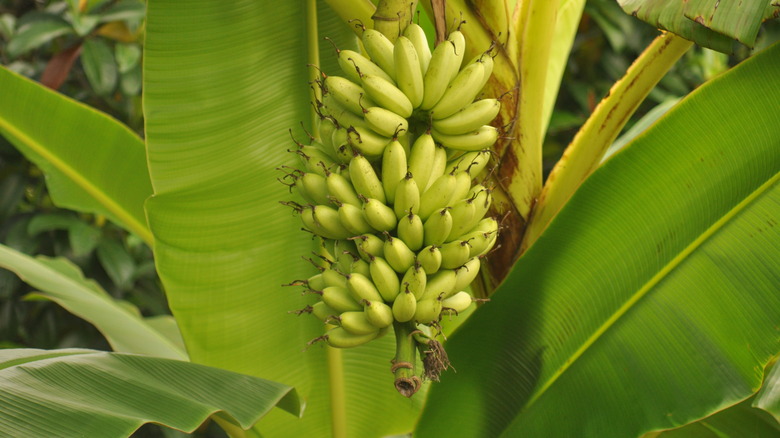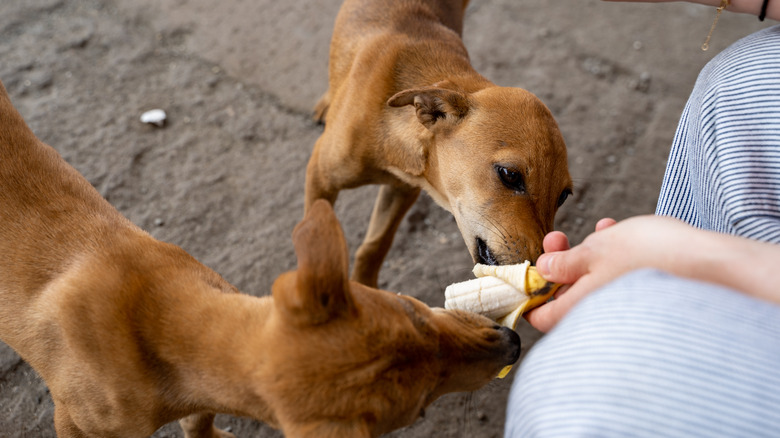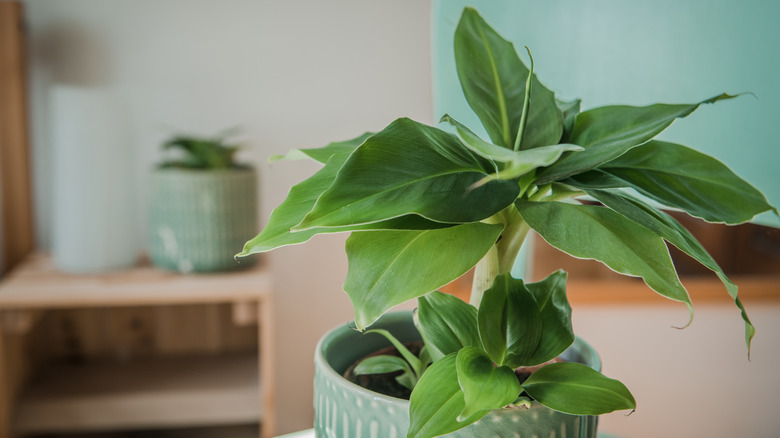Banana Tree: Everything You Should Know Before Planting
Musa, or banana trees, actually aren't trees at all. They are herbaceous perennials which means they are technically giant herbs, per the Petal Republic. Native to several parts of Asia, such as Malaysia and Indonesia, the plant has spread widely across the globe since it was first brought to the Americas sometime around 1000 AD. Today, you can grow a banana tree just about anywhere, assuming you can provide it with the climate and the care it needs. Banana trees prefer warm and humid conditions such as those in eastern Asia. Gardeners can mimic this environment indoors or choose to grow them outdoors if they live in Florida or another hot and humid region.
Banana trees can be identified by their huge green, oblong leaves, and long trunks, but their trunks are unlike the standard variety. According to Royal Botanic Gardens, KEW, they are known as pseudostems and are made of many grouped leaves instead of wood or bark. The plant also boasts white and yellow blossoms and bundles of up to 20 bananas.
How to use banana trees in the garden
Banana trees thrive outdoors in the right conditions. They can grow up to 30 feet tall, depending on the cultivar, and their large leaves spread widely. Your plant will grow best if you keep it in a sunny location and protected from the wind. Though mature banana trees are quite resistant to most threats, younger plants are not as strong.
As told by the University of Florida IFAS, Musa species allow your lawn to look lush, green, and exotic. They are best planted with other ornamental tropical plants such as Birds of Paradise, Heliconia, or ginger. Keep in mind that banana trees and their companion plants typically need warm, humid conditions to survive. If your region often experiences temperatures that dip below 60 degrees Fahrenheit, your banana plant could become damaged. Even worse damage could occur if temperatures drop to freezing — so ensure your garden will maintain its warmth to support your banana trees before planting.
How to grow banana trees
One of the most successful ways of growing your own banana tree is a propagation method from suckers. Suckers, or pups, are lateral shoots that grow next to the parent plant. When removed from the parent, the suckers can develop into healthy and mature banana trees by themselves. Before you begin the process of removing the offshoots, you will need a few things, as described by Home Gardens in a YouTube tutorial. They are a small shovel, a hammer, and a sharp, flat tool such as a wallpaper stripper or a knife. Later, you will also need well-draining sandy loam soil and a self-draining pot.
When you are ready to remove the suckers, start by wedging your sharp, flat tool between the parent plant and the pup. Then, tap it in with your hammer to separate the two shoots. Next, take out your knife or wallpaper stripper and redo this step several times in the soil around the pup to dislodge it. Use your shovel to get leverage under the plant when it is loose and carefully pull it from the dirt. Now, you can fill your new pot about three-quarters of the way with fresh soil and dig a small hole in the center for your suckers' root ball. Place your plant into the hole and cover its roots with your growing medium. Make sure to pack it around the base to secure it in its new home.
How to care for banana trees
To give proper care to a banana tree, you will need to set aside time to water, fertilize, and check on its health regularly. The best thing you can give your banana plant is a warm environment and plenty of indirect sunlight. Despite being a tropical plant, Musa prefers indirect sunlight to full sun conditions, says the Petal Republic. If you are growing yours outdoors, try to find a somewhat shady area for them to thrive in. Indoors, you can place your tree near a south-facing window. Make sure your banana plant receives 8 to 10 hours of light each day regardless of where you place it.
Water is another essential factor. Banana trees hate sitting in water, and their roots should never be soaked for an extended period, as they can develop root rot and similar diseases. However, banana trees are thirsty plants. During their growing season, you should check your banana plant's soil with your finger regularly. Each time the top inch of soil dries out, water it deeply. As winter approaches, your banana tree will need watering less often, but do your best not to neglect it. Fertilization can also help your fast-growing tree develop even faster when applied correctly. Banana plants will benefit from the use of a 5-3-3 fertilizer that is meant for accelerating vegetative growth. Use this once every two weeks in the summer and once per month in the spring, winter, and fall.
Banana tree varieties
It's difficult to say how many cultivars of banana plants exist today. As explained by Growing Anything, there may be more than 1000 varieties between species. Native to many countries in Asia, banana plants have spread rapidly to regions with similar weather conditions, such as Costa Rica, Ecuador, and Florida. Over time, hundreds of banana cultivars have been made and discovered by botanists and hobbyist gardeners, allowing for countless varieties that come in all different sizes and colors. Today, banana plants can grow as small as 2 feet tall or as large as 30 feet. These trees' only similarities are their boomerang-shaped fruit and wide, ovate leaves.
-
Musa acuminata 'Cavendish banana': A popular banana tree whose bananas are most often sold in grocery stores in the United States. Currently, a disease is affecting many of these plants that may wipe them out in the future.
-
Musa troglodytarum 'Fe'i banana': This plant is smaller than many banana trees, and its fruit is smaller too. Its appearance makes it popular in its native region of New Guinea.
-
Musa Orinoco 'Burro banana': This is one of the most vigorous Musa cultivars with excellent wind resistance.
-
Musa acuminate 'Lady Finger banana': With fruit measuring only 3 inches long, this plant is grown as a perennial shrub and is commonly found in Australia.
-
Musa acuminata x Musa balbisiana 'Goldfinger banana': A dwarf variety, the Goldfinger banana plant typically grows only 8 feet tall.
Are banana trees toxic?
As told by the ASPCA, all parts of the banana tree are nontoxic to cats, dogs, horses, and humans. According to the American Kennel Club, bananas are suitable for all mammals as they are rich in vitamins B6 and C and potassium. However, you might not know that banana leaves can also benefit your pet's health. Banana leaves can be used topically to treat skin conditions like rashes and hair loss, or they can be eaten to combat stomach problems like ulcers, explains PatchPuppy.
It's possible that dogs who ingest banana leaves can lower their glucose levels and combat diabetic symptoms. Banana peels do not have the same benefits. Though they are technically nontoxic, feeding your pets banana peels may cause a painful blockage as they are difficult to digest. Ensure you only feed your animals bananas and banana tree products in small amounts to avoid an upset stomach.
How to repot a banana tree
Repotting a young banana tree is straightforward. All you need to get started is a self-draining pot, fresh well-draining sandy loam soil, some gravel, and a knife, as told by SFGate. Prepare your tree's new pot by placing a small layer of gravel at the bottom and filling another third of the container with soil. The gravel will help water drain out more efficiently, so the banana plant's roots do not become soggy.
After preparing your pot, you can remove your tree from its original home. Run your knife along the edge of the container where it meets the soil. This will ensure you can get the tree out easily without damaging its root system. Then, put your banana plant on its side, grip the base of its trunk, and gently pull it from its pot. Once it is out, knock away some of the old dirt and take a look at its roots. Any roots that look brown and mushy indicate root rot; simply cut them off before moving on. Next, place the tree into its new container and hold it straight up as you cover its roots with more soil. Firmly pack the dirt around the plant's trunk to steady it in its pot. Finally, water your banana tree heavily before setting it back in an indirectly sunny area.
